Evaporative Cooling – The Racer’s Edge
Part 2: Post WWII
by Daniel D. Whitney and Peter V. Law
Published 3 Jan 2018
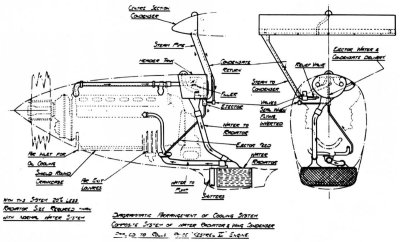 |
This article first appeared in The Journal of the Rolls-Royce Heritage Trust, in two parts. Titled: "Evaporative Cooling – The Racer’s Edge"; Issue No. 6, December 2016 and Issue No. 7, May 2017. The article was inspired by David Birch of the R-RHT. The authors hope that readers will better appreciate the history and technology of some of the efforts that have been made to go really fast in a piston powered aircraft.
|
Immediately following WWII Unlimited Air Racing was restarted, but with the racers typically being surplus fighter aircraft rather than the pre-war homebuilts and specialty racers. These races were abruptly ended after 1949 due to a tragic accident. In 1964 Bill Stead restarted Unlimited Air Racing, but in the wide open spaces around Reno, Nevada. Again the racers were surplus WWII fighters. Soon the competitive nature of the racers resulted in significant modifications, focusing on reducing drag and increasing horsepower. Obvious changes included clipping wings, fitting smaller canopies and increasing the maximum speed of the engine. Internally changes were made too: such as removing armor plating and non essential systems and equipment to make the aircraft lighter. Less obvious were the few airplanes that installed ADI systems on the engines to allow running at the higher power levels, as well as spray bars installed ahead of oil and coolant radiators to compensate for the greater cooling loads when running at high power. A few also installed boil-off systems for cooling engine oil, resulting in a substantial reduction of internal cooling drag on the airframe. See Table 2 for a tabulation of these aircraft and their cooling systems. These systems and their adaptations are discussed next.
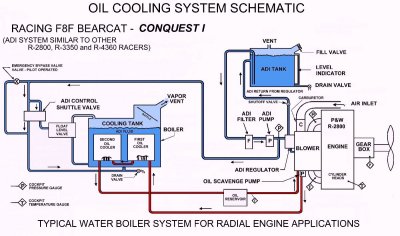 |
| Figure 2. Schematic of the lubrication oil cooling system designed by Pete Law for Darryl Greenamyer’s F8F Bearcat, Conquest I in 1964-1965. Note the diagram shows two oil coolers as actually configured for the Open Cycle oil cooling system in the racer. When ferrying these large radial engined aircraft the oil cooling boiler requires about 0.75 gpm (2.8 l/m), severely limiting range. |
Conquest I, Grumman F8F Bearcat, World Record Holder August 16, 1969
Darryl Greenamyer, a Lockheed Skunk Works® test pilot then flying the 2,100 mph (3360 km/h) Lockheed A-12 vehicle, flew a propeller-driven F8F Bearcat in the inaugural air race at Reno in 1964, where he had finished first, but lost on a technicality. The airplanes that year were basically surplus military fighters with only tune-ups to get them into racing trim. For 1965 Darryl was looking for a performance boost. He had previously tested the Lockheed F-104 jet fighter and was familiar with the boil-off cooling system incorporated in those airplanes Environmental Control System (ECS). He also knew that such a system had been on the German World Record airplanes. He asked Ben Rich, Propulsion Manager at Lockheed’s Skunk Works®, for help in making a similar system to cool the Bearcat’s engine oil. Ben in turn went to Pete Law, a young thermodynamics engineer in Lockheed’s Skunk Works®, who had worked on the F-104 ECS prior to 1961, and asked if he would work with Darryl in this after-hours project. After designing the basic system (Figure 2) Pete needed suitable oil coolers, which he found in a surplus yard across the runway from the Skunk Works® facility in Burbank. He settled on two 10-inch diameter oil coolers that had been used on the Lockheed Constellation transport to cool the oil lubricating the engine driven cabin pressurization superchargers.
With the boil-off oil cooler and other modifications to the airframe, e.g., clipped wings, Darryl won his first Reno Championship in 1965, with five more Championships to come in this same P&W R-2800 powered airplane. On August 16, 1969 he set a new FAI Class C-1 Group I 3 km speed record with a speed of 776.70 km/h (482.624 mph), breaking the record set thirty years earlier by Fritz Wendel in the Messerschmitt Bf 209 V1.
The oil coolers were mounted inside a box approximately 12” x 24” x 14” high. This package was installed in the airframe fuselage, behind the fuel and ADI tanks beneath the pilot’s seat. The vent for vapor then extended through the side of the fuselage. The engine ADI system consumed about 2.5 gpm (9.5 liters/min) of water/alcohol when at race power, and a similar amount of fluid for the oil cooling boiler. A tank held 90 gallons (340 liters) of ADI fluid, so power level greatly determined how long the aircraft could remain in the air. A typical race heat is about eight minutes in length. Similar boil-off oil coolers have been used in a number of other racers over the years.
After more than a decade as a racer Greenamyer donated the airplane to the Smithsonian Institution, where it is now displayed in the Udvar-Hazy Center near Dulles International Airport, Virginia.
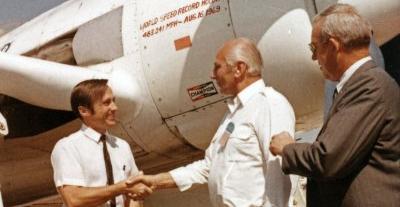 |
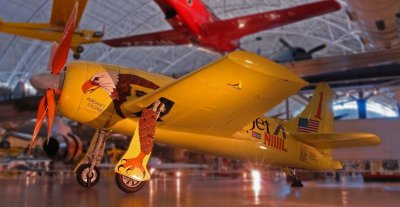 |
| Fritz Wendel congratulating Darryl Greenamyer for besting his 30 year old World Speed Record in 1969. Photo taken at the Lockheed factory, Tony Levier looking on. (Lockheed Aircraft photo) |
Conquest I in its final configuration as American Jet on display at the Udvar-Hazy Center, Smithsonian. The vapor vent for the boiler is just below the “J” in “Jet”. (Dan Whitney photo) |
P-39 Cobra III
In 1968 Mike Carroll reworked the old racer Cobra II to make it even faster. The airplane had a single stage Allison V-1710-135 modified to operate on methanol fuel and deliver 2,000 BHP. Carroll was making the first post-modification test flight, during which he used the newly installed boil-off oil cooler, a configuration similar to that on Conquest I, but installed in the nose gun/ammo compartment. Unfortunately the airplane became uncontrollable during the flight and Carroll abandoned the airplane; tragically he was struck by the airframe and killed, August 10, 1968.
P-63C Crazy Horse Campgrounds #90
Owned by Larry Havens, this 1971/1972 era racer was an extensively modified P-63C. It featured clipped wings, a very small canopy and revised systems focused on going fast. One of the modifications was installation of a boil-off oil cooler, very similar to the arrangement in Conquest I, installed in the nose gunbay of the airplane. The carburetor air scoop was also removed and the air provided by duct work from the wing leading edge to the engine through what had been the oil cooler passages. Prior to the 1972 race season the airplane was lost due to an explosion/backfire in the induction system. The pilot safely abandoned the airplane.
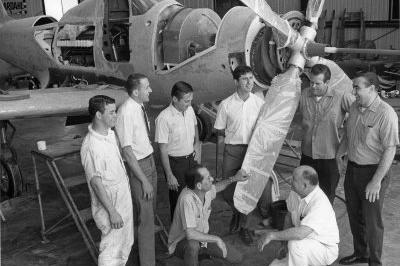 |
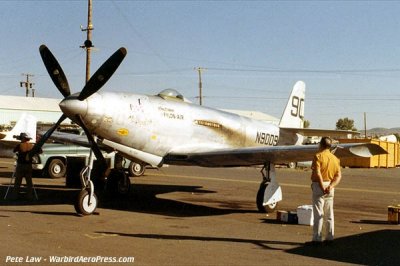 |
| Cobra III The large tank ahead of the cockpit is the ADI boiler for the oil cooler, and the vent is just below the windscreen. ADI fluid for the boiler was carried in the wings. Left to Right: Kirk McQuon, Pete Law, Darryl Greenamyer, Mike Carroll, Dave Zueschel, Bruce Boland, kneeling are Ray Poe and Don Newberger. (From Pete Law collection) |
Crazy Horse, a highly modified P-63C with boiloff oil cooler, at 1971 Reno. (From Pete Law collection) |
The Next Step
With the successful application of boil-off/vapor cooling of the oil, the next step for liquid-cooled engines was to adapt the feature to the engine cooling system. The result was an Open Cycle with complete vaporization of the secondary cooling fluid. Again Pete was asked to assist in this endeavor. His approach involved taking a standard coolant-to-air radiator and immersing it in a bath of boiling liquid. In its first adaptation, in the 1992 version of Stiletto (see Figure 3), the fluid was 50:50 water/ methanol, i.e., ADI fluid.
Note in Figure 3 that there are baffles in the vent path from the boilers. These are very important as they minimize the amount of liquid entrained in the exiting vapor. Any liquid in the venting vapor is not carrying its fair share of energy and is redirected by the baffles back in to the boiling fluid. Any effort to condense the vapor, and thereby reduce the rate of fluid consumption, would in itself require taking cooling air onboard, which would be detrimental to reducing airframe drag.
Stiletto #84
Stiletto debuted at Reno in 1984, having been built by Dave Zueschel and his team in Southern California. Their goal was to have the lightest P-51 racer ever, and to remove as much drag as possible. They were successful in this effort, with the primary changes being removal of the classic P-51D belly scoop, installation of radiators with water spray-bars located in the wings and significantly clipping the wings themselves. Weight changes necessitated moving the pilot’s seat some 20 inches to the rear, as well as placing the 40 gallon (150 liter) engine ADI tank and 12 gallon (45 liter) oil tank behind the pilot.
Piloted by Skip Holm the racer won the Gold its first time out with a speed of 437.621 mph (704.283 km/h). In subsequent years the racer suffered a number of problems with its engine and landing gear. After an aborted effort to eliminate the air-cooled radiators in the wings by installing a boil-off cooling system, pilot Matt Jackson came to the project in 1992. With only two months to get the racer ready for Reno, Pete Law got involved and they were able to get the vapor-cooling system to work. The final configuration of the systems was as shown in Figure 3. The airplane, piloted by Matt Jackson, qualified at 427.319 mph (687.703 km/h) using much less than race power. He reported that during preliminary heat races with the boil-off cooling system he was able to go as fast with 60 inHgA (2.0 atm, 14.7 pounds boost) manifold pressure as other Mustangs using 100 inHgA (3.34 atm, 34.4 pounds boost). Matt only used race power a few times during the heat races on Friday and Saturday, just enough to fully check out his systems. Unfortunately, engine ADI system problems during the Sunday Gold race required a power reduction and Matt finished fourth at 426.219 mph (685.933 km/h)[16]. This was the last time the aircraft appeared as a racer, as it was sold and the new owner returned it to stock TF-51D configuration.
In its original configuration, with air-cooled radiators in the wings, the airplane consumed about 9 gpm (34.1 l/m) of water for the spray bars on the engine coolant and oil cooling radiators, and 4 gpm (15.1 l/m) of ADI into the engine. With the boil-off system, spray bar water was no longer required, and that 100 gallon (379 liters) tank could be devoted to supplying ADI to the boiler. Total ADI fluid quantities, designed for running at race power (3,000 BHP, 2,237 kW) amounted to about 4.0 gpm (15.1 l/m) of ADI into the engine, 1.5 gpm (5.7 l/m) to the oil boiler and 6.8 gpm (25.7 l/m) to the coolant boiler. Stiletto never used an aftercooler boiler, which would have required about 1.9 gpm (7.2 l/m) if it had, though the ADI into the engine would have been reduced by about 1.5 gpm (5.7 l/m). Accounting for the requirements of startup, taxiing, takeoff, form-up, a ten minute race, cooldown and landing could consume as much as 175 gallons (662 liters)of ADI fluid and 110 gallons (416 liters) of fuel. Forty seven gallons (178 liters) of ADI was held in tanks specifically for the engine and two other tanks, with a capacity of 200 gallons (757 liters), held ADI for the boilers. At 3,000 horsepower the calculated peak rate of ADI boiling, to cool the coolant radiator alone, is 5.2 gpm (19.7 l/m).
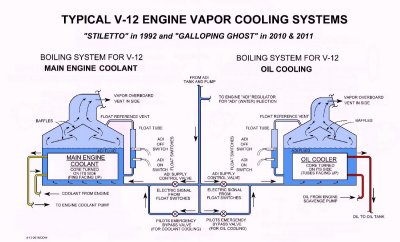 |
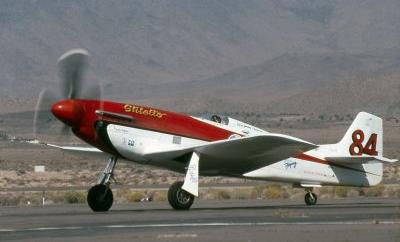 |
| Figure 3. Schematic of the Pete Law designed Open Cycle vapor cooling systems used on the modified P-51D racer Stiletto in 1992. Note that ADI is used as the working fluid for both engine coolant and oil. A 50:50 methanol-water mix boils at 167 °F (75 °C) at sea-level (158 °F/70 °C at Reno’s 5,000 ft/1,525 m elevation, which is ideal for cooling the oil, however it is too low for high-powered engine operation, where 205 to 225 °F (96 – 107 °C) is desired. By either varying the water/alcohol mixture ratio or adjusting the level of ADI in the boiler the effectiveness of the coolant heat exchanger can be adjusted to give the desired coolant outlet temperature. |
Stiletto in 1992 when configured with a ADI boiler providing engine cooling and another for oil cooling. Matt Jackson pilot. (Dan Whitney photo) |
The Galloping Ghost #177
This same Figure 3 system was used in the ill-fated Galloping Ghost. When converted to vapor cooling it was fitted with the lower fuselage structure previously used in Stiletto to replace the P-51D radiator installation, although with a different boiler. Its first outing with vapor systems was in 2010.
This racer used 50:50 water/methanol in the coolant and oil boilers, and was very fast. In its fastest recorded lap around the 8.4 mile (13.52 km) Reno course the GPS reported a peak speed of 532 mph (856.2 km/h), with a minimum of 486 mph (782.1 km/h) in the turns, for an average of 509 mph (819.2 km/h), resulting in a lap speed of 484.02 mph (778.95 km/h). The difference between average actual speed and the lap speed is due to the actual path the racer flew being about 8.8 miles (14.16 km), a necessity to assure that pylons are not inadvertently cut. During this lap the engine was running at 110 inHgA (3.68 atm, 39.3 pounds boost) and 3,450 rpm.
The weight of the aircraft is very important with respect to its maximum speed. Where the P-51D has an empty weight of 7,635 pounds (3,463 kg), the Galloping Ghost empty weight was 6,474 pounds (2,937 kg). When at race power the engine is consuming about 38 pounds per minute (17 kg/m) of fuel, 20 pounds per minute (9 kg/m) of ADI into the engine, 12 pounds per minute (5.4 kg/m) of ADI to the oil boiler, and 53 pounds per minute (24 kg/m) of ADI to the coolant boiler. All together about 120 pounds (54 kg) of consumables are being used every minute, so for an eight minute race a total of 970 pounds (440 kg) is used, plus the fluids needed for warm-up, taxi, takeoff, form-up, cool-down and landing. Something like 1,500 pounds (680 kg) total. Including reserves, takeoff weight would be approximately 8,350 pounds (3,790 kg).
Mr. Awesome #97
This Reno racer began life as an Egyptian Yak-11 trainer. Acquired by Joe Kasperoff he had it modified as a pylon racer, fitted with a Wright R-3350 turbo-compound engine, a cut down Skyraider propeller, a lengthened fuselage, stock wings, an enlarged tail and a Pete Law boil-off oil cooling system. Skip Holm piloted it at Reno 1988 and qualified at 417.274 mph (671.537 km/h), however after Thursday’s heat race he and the owner determined the aircraft was marginally stable and stood down for the rest of the week. It was then sold to Darryl Greenamyer, who installed a T-33 tail section to improve stability. Soon after taking off to qualify Pilot Neil Anderson had an engine failure due to a foreign object in the oil temperature control. During the landing the racer was heavily damaged when one landing gear failed to deploy. No one knows what the racer could really have done.
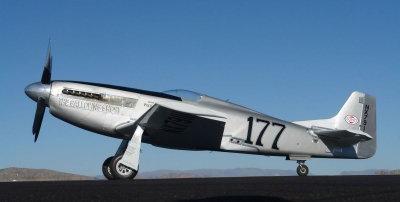 |
 |
| The Galloping Ghost, a highly modified P-51D, returned to racing in 2010 with boilers for both the engine cooling and oil systems. The two vents from the coolant boiler exit the fuselage just in front of the number 177. The oil boiler vented out the opposite side. (Dan Whitney photo) |
Mr. Awesome in 1988. Featured a boiler for oil cooling. (Pete Law collection) |
September Fury #232
This Hawker Sea Fury first appeared at Reno in 1988 as a stock configuration powered by its original Centaurus engine, and then spent a number of years in England. It was purchased in 1998 by Michael Brown who had the aircraft modified by installing a Wright R-3350-93 and a Pete Law boil-off oil cooling system. Brown debuted the racer as September Fury in 2000. During qualifying at Reno in 2002 September Fury clocked 468.266 mph (753.601 km/h), making it the fastest Sea Fury ever. He won the Gold at Reno in 2006 with a speed of 481.619 mph (775.089 km/h), further raising the record for the fastest Sea Fury ever.
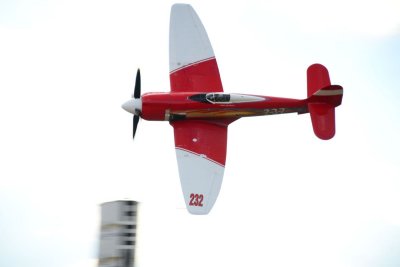 |
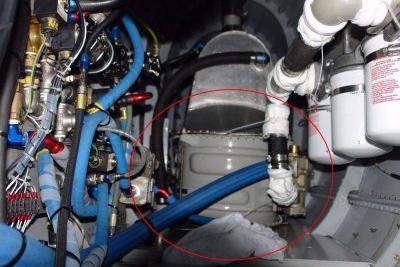 |
| Shuttle astronaut “Hoot” Gibson in #232 rounding Pylon 8 at Reno in 2013. (Dan Whitney photo) |
#232, September Fury, in 2006, showing its boil-off oil cooler (red circle). Note the compact installation with inlet and outlet plenums directly connected to the oil cooler. There is no tank. The white padding wrapped around the pipes on the right are to catch any leaks. The pads are actually Kotex®. (Dan Whitney photo) |
Rare Bear #77
This 3 km World Record Holder (August 21, 1989) is a highly modified perennial racer that began life as a Grumman F8F-2 Bearcat and has received numerous modifications by a series of owners and teams over the years. The most significant of the modifications was in 1969 when Lyle Shelton built the racer from a wreck he purchased and replaced the original P&W R-2800 engine with a Wright R-3350 from a Skyraider, making it the most powerful Bearcat ever.
On August 21, 1989 Rare Bear broke the 3 km World Speed Record with a speed of 528.33 mph (850.24 km/h). In 1972 Rare Bear set a new FAI time-to-climb record (3,000 meters in 91.9 seconds, 9,842.4 ft, or 6,426 ft/min), breaking an unofficial record set by a production F8F-1 Bearcat at the National Air Races in Cleveland, Ohio, flown by Lt. Cdr. M.W. Davenport, November 22, 1946 [10,000 feet (3,048 m) in 94 seconds][17].
In the continuing quest for speed then crew chief Dave Cornell and Pete Law designed and installed a boil-off oil cooling system in 2009. This system resulted in a top speed increase of about 12 knots (13.8 mph, 22.2 km/h).
Furias #15
This P&W R-4360-powered Hawker Sea Fury has had a troubled and varied career. In its most recent incarnation it was fitted with a Pete Law boil-off oil cooler for the first time in 2011. Unfortunately, after several years of restoration and modification, a landing gear folded on landing following its qualifying run of 463.000 mph (745.126 km/h) for the 2012 Reno races and the racer was once again out of the action.
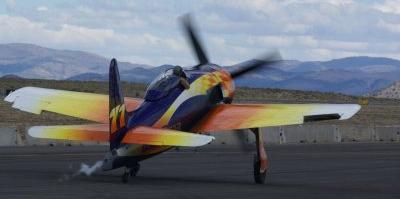 |
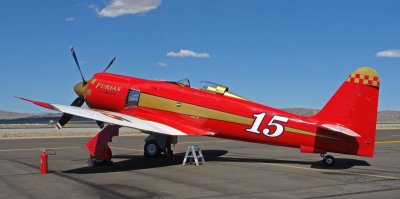 |
| Rare Bear in 2009, its first year with the boil-off oil cooler. Seen here during taxi to takeoff the vapor from the cooler is exhausting through the tail cone exit vent. (Dan Whitney photo) |
Furias at Reno 2012 just prior to qualifying run that ended with a collapsed landing gear. (Dan Whitney photo) |
Vapor Cooling Systems in High Performance Jet Aircraft
The benefits of having the ability to compact, simple and high capacity cooling capability have been adapted to several high performance jet aircraft. This capability is particularly important when the speed of the aircraft results in ram air temperatures much higher than what can be achieved only by including a complex refrigeration system. Since duration is dependent upon the quantity of vapor producing fluid that can be carried their use has been limited to very specific purposes. Examples are the Environmental Control System in the Lockheed F-104 Mach 2 fighter, which used a water boiler to cool bleed air coming into the refrigeration turbine. In the Mach 3+ Lockheed SR-71 Blackbird, water boilers were used to cool high heat rejection surveillance equipment during high speed reconnaissance operations. Another application was in the North American XB-70A Valkyrie, a 1964 era advanced Mach 3+ aircraft that utilized evaporative cooling within its Environmental Control System.
Summary
The concept of vapor cooling has been around since near the advent of flight, and while it has been tried a number of times, the only successful applications have been in specialty aircraft, world speed records, pylon racing, and system cooling within very high speed jets. The aircraft setting the FAI World Record for 3 km in 1939, 1969 and 1989 all had, or eventually had, evaporative cooling systems as a key feature of their high speed capabilities.
The goal of utilizing vapor cooling, with surface condensers reliably delivering cooled liquid to the coolant pump in a Closed Loop system has never been achieved. The problems are legion, such as being able to fabricate complex airfoil shaped, lightweight, condensers able to maintain their shape when pressurized by the hot coolant, and not collapse when vacuum conditions develop during cooldown. Leaks are an issue; however the most serious problem is that the condensate is returning to the pump at a temperature very close to the boiling point of the coolant. Only minor changes in temperature or pressure are sufficient to cause boiling within the pump: the pump is not very good at pumping vapor, coolant flow slows or stops, and the engine immediately overheats.
Open Loop systems, with their inherent limitations regarding range, can be very successful when the mission of the aircraft is compatible. Their post-war adaptation to piston powered racing aircraft, wherein the original cooling and oil systems are retained, and only the cooling fluid is changed, i.e., air for water/methanol mixtures, are weight and performance improvements.
Vapor cooling is a fascinating technology and we have to thank the genius of generations of engineers and designers, as well as the fearless aviators that have pushed the aircraft, to establish these records and to operate at the edge of their speed envelope.
TABLE 2. Post WWII Aircraft with Evaporative Cooling Systems
| Aircraft | Reg Number | Era | Engine | Engine Cooling | Oil Cooling | Comments |
|---|
Heinkel
100 V8 | D-IDGH | 1939 | DB 601 ReV | Closed Loop | Ethyl Alcohol Boiler | Water, Closed Loop design, engine. Ethyl Alcohol boiler/condenser for oil cooling |
Messerschmitt
Bf 209 V1 | D-INJR | 1939 | DB 601 ReV | Open Loop for Record | Annular Radiator | Water |
Kawasaki
Ki-61 & Ki-64 | NA | 1943-44 | Ha-40 | Closed Loop | Unknown | Kawasaki Ha-40 license-built DB 601 A |
Conquest I
F8F Bearcat | N1111L | 1965 | R-2800 | Air-Cooled | ADI Boiler | ADI Boiler is Open Loop |
Cobra III
P-39 | NX92949 | 1968 | V-1710-135 | Radiator | ADI Boiler | ADI Boiler is Open Loop |
Crazy Horse
P-63C | N9009 | 1971 | V-1710 | Radiator | ADI Boiler | ADI Boiler is Open Loop |
Mr. Awesome
Yak-11 | N134JK | 1988 | R-3350 | Air-Cooled | ADI Boiler | ADI Boiler is Open Loop |
Stilleto
P-51 | N332 | 1992 | V-1650 | ADI Boiler | ADI Boiler | Open Loop, No Aftercooler |
September Fury
Sea Fury | N232MB | 2000 | R-3350 | Air-Cooled | ADI Boiler | ADI Boiler is Open Loop |
Rare Bear
F8F Bearcat | N777L | 2009 | R-3350 | Air-Cooled | ADI Boiler | ADI Boiler is Open Loop |
Galloping Ghost
P-51 | NX79111 | 2010 | V-1650 | ADI Boiler | ADI Boiler | Open Loop, Aftercooler with ADI Boiler in 2011 |
Furias
Sea Fury | N985HW | 2011 | R-4360 | Air-Cooled | ADI Boiler | ADI Boiler is Open Loop |
| Lockheed F-104 | Various | 1958 | J79 | None | None | Environmental Control System Only-Open Loop |
| Lockheed SR-71 | Various | 1964 | J58 | None | None | Mission Equipment-Open Loop |
| North American XB-70A | 62-0001 | 1964 | YJ93 | None | None | Environmental Control System Only-Open Loop |
Notes
[16] Students of the P-51 will notice that this speed is practically the same as the stock P-51B, 426 mph, achieved with a V-1650 Merlin at 67 inHgA, 3,000 RPM. Notice that Stiletto’s speed was the average on the pylon course, while the P-51B speeds are straight and level. Significantly, the P-51B speed was at 24,000 feet, running in Hi-Blower. Stiletto was running at about 7,400 feet density altitude, where the P-51B could do 395.5 mph, straight line. See "Flight Tests on the North American P-51B-15", Memo Report ENG-47-1749-A, 20 May 1944.
[17] Grumman Aircraft Since 1929, Renee Francillon, page 251.













